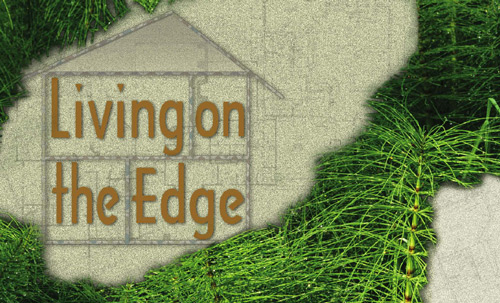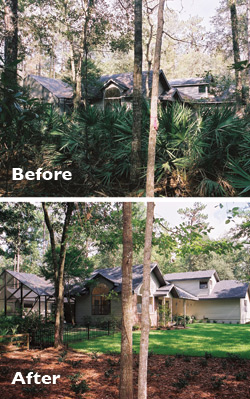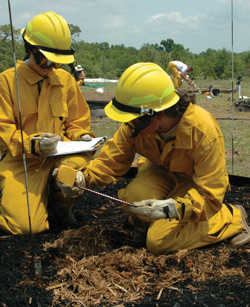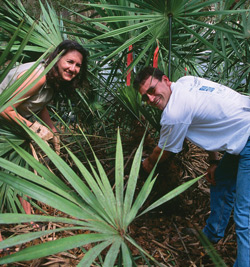|
|

12,000 years ago, there was nobody around when fires burned regularly through Florida’s forested landscape. 400 years ago, Native Americans simply moved on when fire threatened. Eight years ago, forest fires caused $600 million in damages in Florida, and everybody noticed. Those catastrophic 1998 fires focused attention like never before on the wildland-urban interface, or WUI — that moving border between the forest and development. But fire is only one of the challenges in the interface, says Annie Hermansen-Báez, manager of the USDA Forest Service’s Southern Center for Wildland-Urban Interface Research and Information (WUI Center) located on the UF campus. “Though fire is a critical issue in the wildland-urban interface, it is but one of the many issues affecting the condition, health and management of forest resources,” says Hermansen-Báez, who co-edited a comprehensive assessment of the WUI in the South. “Other critical issues include economics and taxation, demographics, land-use planning and policy, recreation, urban wildlife, water quality and quantity, and many more.”
Over the last four decades, a lot of people have moved into the Southern woods. The South is the nation’s fastest-growing region — with a 14-percent increase in population between 1990 and 2000. More than 12 million acres of forestlands are projected to be lost to accommodate this growth. By looking at housing data and vegetation cover, researchers have estimated the WUI accounts for about 9 percent of the continental United States, or more than 175 million acres. In the South, an average of about 21 percent of the land is in the interface. “We have much more intermixing of land uses and a higher degree of parcelization and fragmentation of forests than other regions of the country,” says Ed Macie, team leader of the WUI Center. Adds Hermansen-Báez: “It’s not so much about where the interface is located but how interface issues affect our ability to manage and conserve natural resources.” People move to the country for many reasons — cheaper land, less traffic, simpler way of life. But as more of them seek this lifestyle, their numbers alter the characteristics that attracted them in the first place. And many of these new residents fail to recognize their impact on the forest or the risks associated with living on the edge, says Martha Monroe, a UF associate professor of environmental education and frequent collaborator with the WUI Center. “People living in the WUI recognize they have fewer neighbors and more vegetation around them, but I don’t know if they take that information and say ‘Aha, that means my risk of fire is increased,’” Monroe says. That certainly seems to be the case in Palm Coast, a bedroom community of retirees carved out of a pine plantation on the Atlantic coast in Flagler County, about halfway between Daytona Beach and St. Augustine. “Many of the early inhabitants were retirees from New York, New Jersey and Michigan, anxious to enjoy their later years with sunshine, ocean breeze and low-maintenance lots,” Monroe says. “Most of them had no idea they were moving into an area that was likely to experience wildfire.” They should now. Twice in 13 years, wildfire has engulfed Palm Coast. In 1985, fire destroyed 130 homes and in 1998 more than 100,000 people were evacuated and 70 homes were destroyed. “We interviewed folks in Palm Coast and I think they would say it took both fires before real change occurred at the community level,” Monroe says. Over the last 20 years, fire agencies across the country have pursued a program called Firewise, which is described as an “effort to protect people, property and natural resources from the risk of wildland fire — before a fire starts.” But educating people about fire and getting them to act are two different things, Monroe says. “Our research shows that it’s not just new people who don’t understand,” Monroe says. “We interviewed 80 people who have lived in Palm Coast since before the ‘98 fires. Some of those people have done what they need to do, but others have no intention of doing what they need to do because they like the way it is.” Though there are many issues associated with the WUI, fire often still comes to the fore. After all, it was the 1998 fires that prompted the Forest Service to commission an extensive assessment of the WUI in the South. Hermansen-Báez — who had just completed her master’s degree in forestry at UF when the fires ignited — spent the next three years collaborating with Macie on the 160-page WUI assessment, titled Human Influences on Forest Ecosystems. “In 1998, Florida wildfires demonstrated the complexities of natural resource management in the wildland-urban interface,” Peter J. Roussopoulos, director of the Forest Service’s Southern Research Station, wrote in the foreword to the report. “Shortly after these fires, the chief of the USDA Forest Service identified the wildland-urban interface as one of the main challenges for the Forest Service in the South.” Researchers in UF’s School of Forest Resources and Conservation and the WUI Center have been working with state and federal forestry professionals to develop ways to help people to live in the WUI more safely. “Part of the strategy is to help people understand what they can do that will still retain the values they have for their landscape,” Monroe says. “They want to see trees out their windows, and they want trees to shade their homes and reduce their energy bills. There are all sorts of reasons they’ve moved where they are and they don’t want it converted into a parking lot. I think there are ways to help people understand how they can reduce their risk and still maintain what they want to see in their yard.”
Figuring Out Flammability
In 2002-2003, a coalition of federal, state and local agencies developed and funded a project in Alachua County to retrofit a Florida home and surrounding yard to reduce its vulnerability to wildfires, as well as other hazards. From clearing away vines and bushes to replacing wooden fences with aluminum and wood siding with concrete siding, the researchers identified and carried out dozens of ways to make a house in the forest less vulnerable to fire. “The general principle is that you want to keep things away from the house that might cause it to ignite,” says Alan Long, a professor in UF’s School of Forest Resources and Conservation. “You want to reduce the presence of the most likely ignition sources.” In Florida, that’s things like pine straw and palmettos. In Texas, it might be dry grass or red cedars. “It’s not that you can’t have plants around your home,” says Monroe. “It’s just a matter of what kinds of plants, how tall do they grow, how flammable are they?” In a joint project with the WUI Center, UF and the National Institute of Standards and Technology (NIST), researchers are doing carefully controlled burns of different types of shrubs and mulches, two items that contribute heavily to wildfire house damage. Shrub studies were conducted in two phases. A preliminary study by then UF graduate student Anna Behm Masozera looked at the flammability of shrubs found in the understory of the pine flatwoods and hardwood hammock ecosystems of the southern coastal plain. From this study, the researchers came up with four measures that could be used to rank plant flammability: ignitability, the amount of time it takes a plant to start burning; combustibility, how rapidly or intensely a plant burns; sustainability, how long a plant will burn; and consumability, how completely the plant burns. Based on results of this study, the researchers developed a flammability key that can be found on the WUI Center’s Web site, www.interfacesouth.org. The key can help fire professionals, urban foresters, extension agents and others to create fire-wise plant lists for homeowners. The second phase of studies on shrub flammability was conducted at NIST’s Building and Fire Research Laboratory in Gaithersburg, Maryland. Nearly three dozen noninvasive shrub species commonly used in landscaping across the South were tested for factors such as time until ignition, heat release rate, and maximum flame height. A ranking of the 34 species was generated and the information helped to validate and refine the flammability key. The researchers recently began tests on mulches. Last spring, they constructed test beds about 13 feet in diameter of pine needles, small and large pieces of pine bark and shredded cypress. They mimicked rainfall conditions for 15-day and 30-day drought, and then set the mulch on fire. Using monitors placed in the mulch, they closely tracked the speed with which the fire spread through the pile. Tags painted with paints that melt at different temperatures from 200 to 800 degrees Fahrenheit provided data on how hot the mulches burned. Pine straw spread faster, deeper and hotter than any of the other mulches, and had the highest flames. Large pine bark was a distant second. “Watching these tests, it’s not hard to understand why you don’t want pine straw up next to your house,” Long says. Altering Attitudes
One of the greatest challenges for foresters and other natural resource professionals is the changing personality of rural landowners in the South. From 1978 to 1993, the number of forest landowners in the South increased by 12 percent. Out of the approximately 5 million landowners in the South, 4.1 million own fewer than 50 acres. Descendents of farmers who once owned hundreds of acres have moved to the city and are selling off the family property to developers who subdivide it into five-acre or one-acre or even quarter-acre lots. "Tract size is going down and the number of landowners is going up," Hermansen-BŠez says. "These new landowners tend to come from a more urban background. Some of them have a negative image of forestry because they don't know very much about forest management." While in the past foresters might have dealt primarily with other professionals, like a manager for the St. Joe Paper Co., for instance, today they may have to deal with a landowner who has a completely different view of the forest. "Natural resource professionals have to adapt to a totally different kind of client," Hermansen-BŠez says. "Traditionally foresters weren't trained to work with the diverse group of people you find in the interface. Many foresters went into forestry to be able to just work in the woods." In response, people like Hermansen-BŠez and Monroe have developed comprehensive new training programs to educate natural resource professionals on how to work with different types of forest users. "Changing Roles: WUI Professional Development Program" consists of four modules covering WUI issues and connections, managing interface forests, land-use planning and policy, and communicating with interface residents and leaders. "Communication is perhaps the most important skill that ties together the different activities of a resource professional working in the interface," according to the training material. Monroe says the development team tried to make the training materials flexible so that different agencies and regions could adapt them to their own unique needs. "Our job was to create the materials and pass them on to the agencies and let the agencies use them in house with their own professional development programs," Monroe says.
Interface OpportunitiesWhile much focus is on the challenges in the wildland-urban interface, such as fire, Hermansen-Báez prefers to focus on the many opportunities created by the wildland-urban interface. One opportunity relates to woody biomass. “Because of energy concerns, biomass is a popular topic right now, and there’s a lot of woody biomass at the interface, everything from urban yard waste to hurricane debris,” says Hermansen-Báez. “The University of Florida is really taking a lead in developing alternative fuels, so there is a lot of opportunity for collaboration.” One such collaboration is the Wood to Energy outreach program being developed by UF, the WUI Center and other partners. The program is funded through the U.S. Department of Energy/USDA Biomass Initiative and its goal is to encourage the use of woody biomass for bioenergy production in communities at the wildland-urban interface in the 13 Southern states and Puerto Rico. The outreach development team includes UF faculty from many disciplines, including forestry, food and resource economics, and agricultural and biological engineering. “The South is a prime location for using woody biomass to produce energy,” Monroe says. “The South already has more cities with forests within 50 miles than any other part of the United States. This close proximity of forests to urban areas means a continuous source of biomass fuels without excessive transportation costs.” Annie Hermansen-Báez Alan J. Long Martha Monroe Related Web site: |


